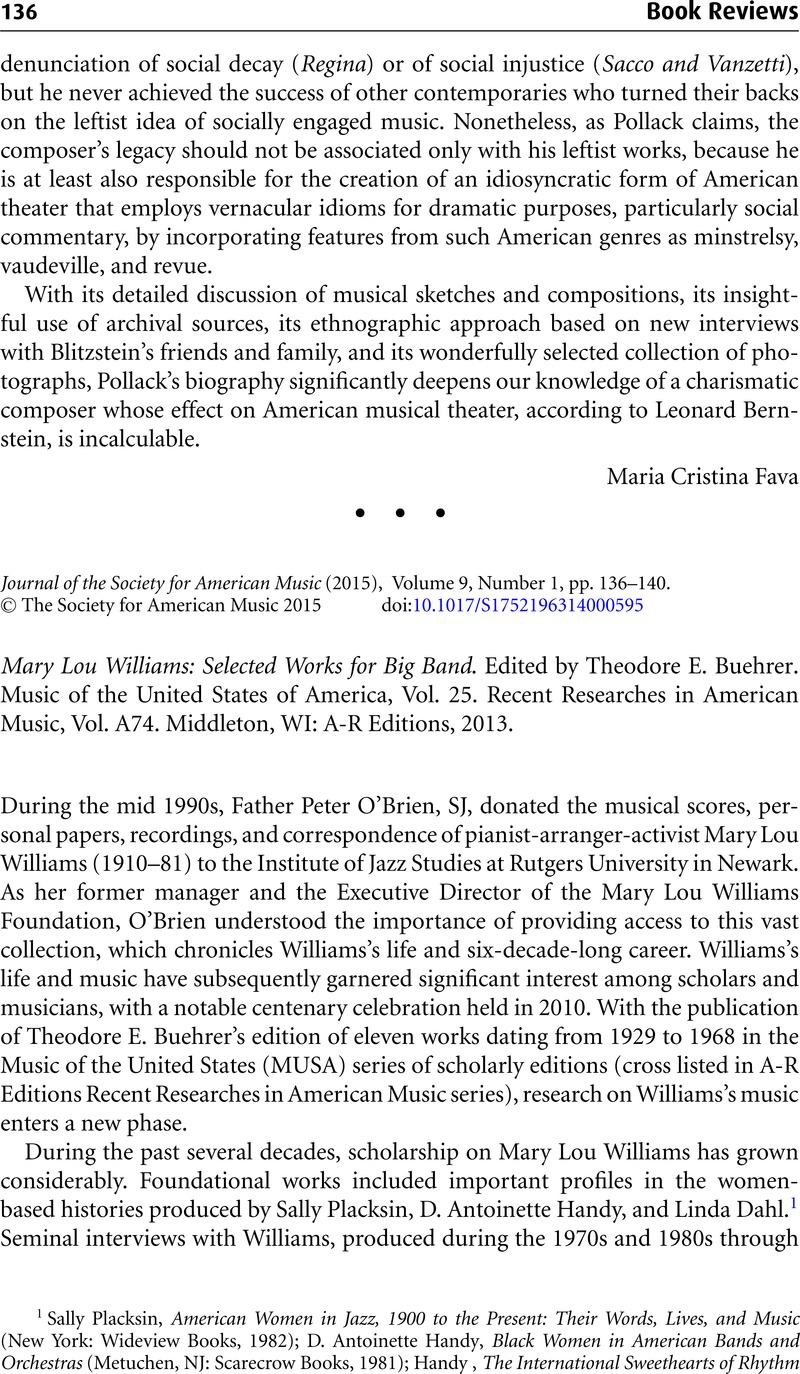No CrossRef data available.
Published online by Cambridge University Press: 04 February 2015

1 Placksin, Sally, American Women in Jazz, 1900 to the Present: Their Words, Lives, and Music (New York: Wideview Books, 1982)Google Scholar; Handy, D. Antoinette, Black Women in American Bands and Orchestras (Metuchen, NJ: Scarecrow Books, 1981)Google Scholar; Handy, , The International Sweethearts of Rhythm (Metuchen, NJ: Scarecrow Books, 1983)Google Scholar; Dahl, Linda, Stormy Weather: The Music and Lives of a Century of Jazzwomen (New York: Pantheon Books, 1984)Google Scholar.
2 The Jazz Oral History Project was established in 1972 by the Jazz Advisory Panel of the National Endowment for the Arts’ Music Program and was later administered by the Smithsonian Institution. It was transferred in 1979 to the Institute of Jazz Studies at Rutgers University–Newark. See Jazz Oral History Project, http://newark www.rutgers.edu/IJS/OralHistory.html.
3 See interviews with Mary Lou Williams and Father Peter O’Brien, 16 and 17 March 1981, Oral History of American Music, Yale University, http://www.library.yale.edu/about/departments/oham/marylou_williams.html.
4 Among other recordings by Mary Lou Williams on the Folkways and Smithsonian Folkways labels, see The History of Jazz (Folkways Records LP 2860); and Mary Lou Williams Presents Black Christ of the Andes (Smithsonian Folkways CD SFW40816).
5 Dahl, Linda, Morning Glory: A Biography of Mary Lou Williams (New York: Pantheon Books, 1999)Google Scholar; Kernodle, Tammy, Soul on Soul: The Life and Music of Mary Lou Williams (Boston: Northeastern University Press, 2004)Google Scholar.
6 Williams taught at Duke University as Artist in Residence from 1977 to her death in 1981. The university paid tribute to her through the establishment of the Mary Lou Williams Center for Black Culture (https://studentaffairs.duke.edu/mlw/about-us).
7 Ellington, Duke, Music Is My Mistress (Garden City, NY: Doubleday, 1973), 169Google Scholar.
8 Murchison, Gayle, “Mary Lou Williams's Hymn Black Christ of the Andes (St. Martin de Porres): Vatican II, Civil Rights, and Jazz as Sacred Music,” Musical Quarterly 86/4 (Winter 2002): 591–629CrossRefGoogle Scholar; Charles Wilkins Pickeral, “The Masses of Mary Lou Williams: The Evolution of a Liturgical Style,” Ph.D. diss., Texas Tech University, 1998; Hairston, Monica, “Gender, Jazz, and the Popular Front,” in Big Ears: Listening for Gender in Jazz Studies, ed. Rustin, Nichole T. and Tucker, Sherrie (Durham, NC: Duke University Press, 2008), 64–89Google Scholar.
9 See Sherrie Tucker, “Big Ears: Listening for Gender in Jazz Studies,” Current Musicology (Spring 2001/2002): 375–408; and Kernodle, Tammy L., “Black Women Working Together: Jazz, Gender and the Politics of Validation,” Black Music Research Journal 34/1 (Spring 2014): 27–55CrossRefGoogle Scholar.
10 Ake, David, “Re-Masculating Jazz: Ornette Coleman, ‘Lonely Woman,’ and the New York Scene in the late 1950s,” American Music 16/1 (1998): 25–44CrossRefGoogle Scholar; Tucker and Rustin, ed., Big Ears: Listening for Gender in Jazz Studies (Durham, NC: Duke University Press, 2008); Monson, Ingrid, “The Problem with White Hipness: Race, Gender and Cultural Conceptions in Jazz Historical Discourse,” Journal of the American Musicological Society 48/1 (1995): 396–422CrossRefGoogle Scholar.